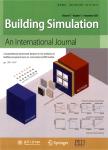Dynamic thermal performance and energy-saving potential analysis of a modular pipe-embedded building envelope integrated with thermal diffusive materials
作者机构:College of Architecture and ArtHefei University of TechnologyHefei 230601China College of Architecture and Urban PlanningAnhui Jianzhu UniversityHefei 230601China State Key Laboratory of Green Building in Western ChinaXi'an 710055China
出 版 物:《Building Simulation》 (建筑模拟(英文))
年 卷 期:2023年第16卷第12期
页 面:2285-2305页
核心收录:
学科分类:070801[理学-固体地球物理学] 07[理学] 0708[理学-地球物理学]
基 金:the National Natural Science Foundation of China(No.52208103) the Youth Fund of Anhui Natural Science Foundation(No.2208085QE163 and No.2108085QE241) the Anhui Province University Outstanding Scientific Research and Innovation Team(No.2022AH010021) the Opening Fund of State Key Laboratory of Green Building in Western China(No.LSKF202303) the Housing and Urban-Rural Construction Science and Technology Program of Anhui Province(No.2022-YF062)
主 题:building energy efficiency pipe-embedded building envelope thermal diffusive material thermal characteristics numerical simulation
摘 要:In the context of racing to carbon neutrality,the pipe-embedded building system makes the opaque envelopes gradually regarded as the multi-functional element,which also provides an opportunity for thermal insulation solutions to transform from high to zero-carbon *** on the re-examination of the heat transfer process of conventional pipe-embedded radiant(CPR)walls,the modular pipe-embedded radiant(MPR)wall integrated with thermal diffusive materials is proposed to enhance the heat transfer capacity of CPR walls in the direction parallel to the wall surface,thereby forming a more stable and continuous invisible thermal barrier layer inside the opaque envelopes.A comprehensive thermal and energy-saving analysis study regarding the influence mechanism of several key factors of MPR walls,e.g.,the inclination angle of the filler cavity(θ-value),geometry size of the filler cavity(a:b-value)and thermal conductivity of the filler(λf-value),is conducted based on a validated numerical *** show that the dynamic thermal behaviors of MPR walls can be significantly improved due to that the radial thermal resistance in the filler cavity of MPR walls can be reduced by 50%,while the maximum extra exterior surface heat loss caused by the optimization measures is only 2.1%.Besides,a better technical effect can be achieved by setting the major axis of the filler cavity towards the room side,where the interior surface heat load/total injected heat first decreases/increases and then increases/decreases with the increase of theθ-*** particular,the MPR wall withθL=60°can obtain the best performance when other conditions remain the ***,the performance indicators of MPR walls can be further improved with the increase of the cavity size(a:b-value),while showing a trend of rapid improvement in theλf-value range of 2–5λC and slow improvement increase in theλf-value range of 5–12λ*** addition,the improvement effect brought by optimizing theθ-value is more o



